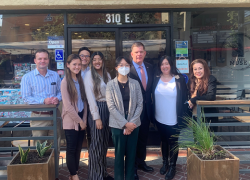
Data is at the center of the U.S. Department of Labor’s good jobs strategy. We work with federal partner agencies to ensure that workforce data is collected and made public whenever possible. For example, we partnered with the Department of Commerce to craft a requirement for subgrantees of its Broadband Equity, Access, and Deployment program to report the demographic composition of their workforce as well as wages and benefits by worker classification for certain projects. Internally, we use data on in-demand occupations to align workforce development resources so they support career pathways to high-quality infrastructure jobs. Our enforcement agencies also use data on workplace violations to better protect workers employed in infrastructure jobs.
Because we know how important data is to a good jobs strategy, we recommend that other agencies and entities keep the following in mind when crafting and implementing their own strategies:
- Start early by collecting demographically disaggregated data on employment, including job hours worked, and job quality characteristics such as wages, benefits, paid leave or access to supportive services. Since new data collections can take significant time to create and implement, it is crucial that any organization looking to harness data to measure and improve job quality and equity begin planning their data strategy far ahead of time.
- Additionally, robust data collection and reporting is only the beginning of a data strategy. It is just as important to think critically about how to use data to improve program implementation and inform future funding opportunities. This often requires conducting intersectional analyses, such as comparing data from women of color to overall averages, to understand how the interaction of demographic characteristics impacts job quality.
State and local governments, grantees, employers, labor organizations and community groups can play a major role in leveraging infrastructure investment workforce data to promote quality jobs. Governments that receive grant funding should determine if they can require grantees and contractors to report additional data beyond the requirements listed in agency funding announcements. Labor organizations can negotiate for employers to collect and report workforce data through Project Labor Agreements. Community-based organizations and regional stakeholders can collect data through community monitoring initiatives and analyze publicly available data to help grantees and contractors realize their workforce development, job quality, DEIA objectives, and local and economic hire promises and responsibilities. And employers can share publicly the workforce information that they already collect, such as EEO-1 mandatory reports, whether through publication or directly with trusted community partners.
There are still many untapped opportunities for federal agencies to improve how infrastructure job quality data is collected, reported and used. This may include developing and adopting standardized workforce data collection requirements and forms. It could also involve establishing widely applicable job quality metrics and performance measures. Furthermore, the federal government could invest in tools and platforms to make this information accessible and useable by stakeholders. Many of these opportunities also apply to state, local and tribal governments that receive grant funding and award contracts. A whole-of-government and whole-of-society approach demands that all stakeholders use data throughout infrastructure programs and project development and implementation to ensure equitable and high-quality jobs.
Authors: This blog series was a collaborative effort by the Good Jobs Initiative, Women's Bureau, and the Office of Federal Contracting Compliance Programs. A special thanks to the Office of Disability Employment Policy, the Employment and Training Administration, and the Veterans’ Employment and Training Service.
Editor’s note: This blog post is part of a series on the Good Jobs Initiative. Read the other posts here:
- Leveraging Federal Dollars to Create Good Jobs
- There’s No One-Size-Fits-All Approach to Advancing Job Quality and Equity
- Creating More Equitable Pathways to Good Jobs
- Data is the Cornerstone of an Equitable Jobs Strategy
- Building an Equitable Workforce Requires Partnerships at Every Level
This document contains links to information created and maintained by other public and private organizations. Please be aware that the U.S. Dept. of Labor does not control or guarantee the accuracy, relevance, timeliness, or completeness of this outside information. Further, the inclusion of links to particular items is not intended to reflect their importance, nor is it intended to endorse any views expressed or products or services offered by the author of the reference or the organization operating the site on which the reference is maintained.

 U.S. Department of Labor Blog
U.S. Department of Labor Blog




